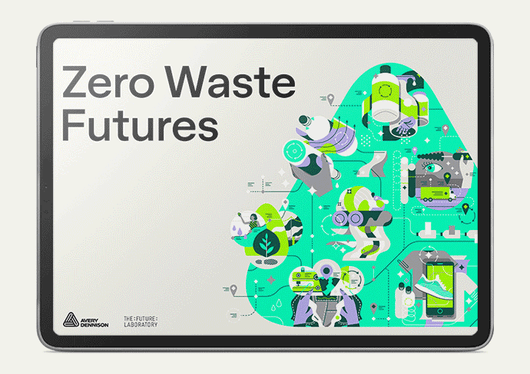Zero Waste Futures
A Foresight Report for Avery Dennison
Building a zero waste future requires rethinking the economics of waste, and problem-solving from multiple angles in order to create end-to-end solutions that both lessen waste and prevent it from the outset. Avery Dennison commissioned The Future Laboratory to produce a new foresight report identifying these solutions and emerging trends driving change
Across the globe, two billion tonnes of waste are generated each year, according to the World Bank. Consumers are confronted with waste on a daily basis, from expired foods in their refrigerators to unworn clothing in their closets and nonrecyclable packaging in their rubbish bins. Brands, retailers and manufacturers are confronted with it too – across the supply chain, inventory loss and inefficiencies lead to wastage, while overproduction and misestimations lead to disposal of unwanted stock.
Innovation in materials can make products and packaging more recyclable, and more likely to stay within the loop longer. Technological and digital ID innovations will give us unprecedented visibility over the supply chain, creating more efficient inventory management and allowing businesses to eliminate unnecessary waste. ‘There will be no silver bullet,’ says Chaffo. ‘It’s going to be many, many solutions, working in harmony to drive positive outcomes.’
Combining expert interviews with consumer insight, The Future Laboratory identified the emerging trends and attitudes that will will drive transformation in the decade ahead. This report examines some of these solutions, that when taken together paint a picture of how a zero waste future might be achieved, in order to create a world where waste is not only mitigated, but eliminated.
: Drivers
 The R Collective
The R Collective
Increasingly sustainable mindsets, debates over consumption and plastic waste, new waves of legislation and a realisation amongst brands and retailers that avoiding waste is good for business are all driving forward a zero waste future.
: Sustainable mindsets
Consumers’ demand for action on sustainability – commingled with a realisation amongst brands and retailers that waste reduction offers tangible value – is pushing new circular systems.
: Less or better?
There is a current tension in how we tackle waste in a society defined by mass consumption. Should the focus be on reducing the waste through the ‘reduce, reuse, recycle’ philosophy? Or should we be looking to create new systems, materials and products that are better suited to a circular economy from the start?
: The plastic debate
When it comes to waste, perhaps nothing is more contentious than plastic. From a consumer perspective, plastic packaging has become a visible representation of humanity’s impact on the planet, with images of plastic debris floating among marine life leaving an impressionable mark.
‘Plastic in and of itself is an amazing material. It’s light,
it’s durable. If you’ve got a plastic bottle, you could
keep that for 100 years and just keep reusing it.’
Andrew Morlet, CEO, Ellen MacArthur Foundation
: Trends
The classic ‘reduce, reuse, recycle’ approach to waste is undergoing an overhaul, with innovative businesses changing how waste is perceived, diverting it from landfills and eliminating it altogether.
Some of the trends emerging from this overhaul include:
: Valuable Waste
By definition, waste is thought of something that nobody wants or can use – it is there to be discarded. But waste should be viewed not as useless, but as something that can be harnessed as a resource. Landfills, for instance, are brimming with precious minerals within discarded electronics. Researchers have found there is more gold, palladium and silver within landfills than in natural ores in the ground.
: Embedding eco-design
One key route to reducing waste is designing it out at the initial phases of concept development. ‘Eighty percent of the decisions you make during the design phase will determine how sustainable your product will be in the end,’ says Rob Groenin ‘t Wout, Marketing Manager Films at Avery Dennison. The World Economic Forum (WEF)’s Net Zero Challenge report suggests that key to businesses tackling supply chain emissions is to redesign their products and value chains for sustainability. Indeed, some brands are already embedding principles of eco-design into their products from the beginning, to ensure that the environment is at the core of their proposition, rather than an afterthought.
: Carbon labelling
Many consumers don’t know where to begin when it comes to making environmentally sound choices. In a survey by Futerra, 88% of American and British consumers stated they wanted brands to help them be more environmentally friendly in their daily lives. Carbon output is one metric brands are now using to help consumers understand the impact products have on the environment, with some adding carbon labels to their products to help consumers make more considerate choices.
Discover our Sustainability series on LS:N Global – the ideas, innovations and actions your brand can take today to become part of an eco-conscious tomorrow.
‘Eighty percent of the decisions you make during the design phase will determine how sustainable your product will be in the end. ’
Rob Groen in ‘t Wout, Marketing Manager Films, Avery Dennison: Futures
As more governments and businesses commit to a zero waste future, there will be increased investments in novel materials as well as technologies and systems that promise to reduce waste, increase sustainable impact and scale up circularity.
: Biomimicry materials
Achieving zero waste in manufacturing requires multiple approaches. While recycling existing materials is vital, many designers are researching new materials that mimic the cycles of nature, where resources are grown, used and then degrade back into the system to regenerate anew.
: Lifecycle visibility
In order to reduce waste, we need to know where it is occurring along the supply chain. New digital platforms and technologies are opening up supply chain transparency, which will in turn enable more circular systems. These technologies promise the ability to trace raw materials, prevent waste before it begins, improve post-consumer recycling and create a new value system by which to judge products.
: Circular ecosystems
In order to achieve circularity at scale, there needs to be buy-in and collaboration from multiple stakeholders all along the supply chain – from product design, packaging and production to consumers to end-of-life disposal. In the apparel industry, new consortiums and collaborations are offering a blueprint for how to close the loop on production.
To learn more from about Zero Waste Futures, download the full report here.
If you are interested in finding out more about our Foresight reports that combine quantitative and qualitative research with original case studies and innovations to achieve your business objectives, click here.
For more about our client reports and case studies, get in touch with a member of our team.
FIND OUT MORE
.png)
